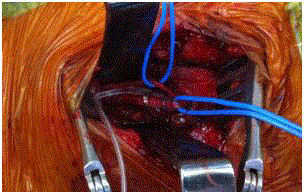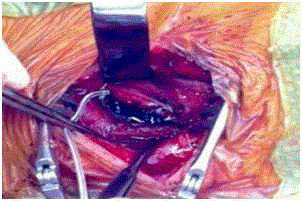Clinical Image
Rare Side-Effect of Vagal Nerve Implantation
Herbert Rooijakkers, Vincent Vanthuyne and Christian Raftopoulos*
Department of Neurosurgery, St-Luc University Hospital, Belgium
*Corresponding author: Christian Raftopoulos, Department of Neurosurgery, University of Catholic Louvain (UCL), 1200 Brussels, Belgium
Published: 16 Jul, 2018
Cite this article as: Rooijakkers H, Vanthuyne V,
Raftopoulos C. Rare Side-Effect of
Vagal Nerve Implantation. Clin Surg.
2018; 3: 2032
Keywords
Vagal nerve; Epilepsy; Muscle spasms
Clinical Image
Objective: This case report shows a rare side-effect at implantation of Vagal Nerve Stimulation
(VNS) during intra-operative system diagnostic testing.
Case Description: VNS is a procedure well known in the literature for treating medically
refractory epilepsy. We implanted in September 2014 a VNS on a sixteen-year-old girl with focal
cryptogenic temporal lobe epilepsy. She benefited from surgery in May 2011 with a disconnection
of the left anterior temporal lobe associated with subpial transactions in the area of Wernicke.
The patient suffered from 15 to 20 focal seizures per month with impaired consciousness. Her
pharmacological treatment consists in Lamictal Depakine and Frisium. The VNS implantation went
uneventful, but during system diagnostic testing at an Output Current of 1.0 mA (set automatically
when device is switched off), heavy muscles spasms were observed (platysma, sternocleidomastoid
and omohyoid muscles). We repositioned the electrode 1cm caudal on the vagal nerve, but still the
contractions occurred during the device diagnostic testing. We tried a lower output current of 0.25
mA overriding the default 1.0 mA setting but still heavy contractions were observed. At a closer look
on the vagal nerve we could dissect a small branch of external superior laryngeal nerve, vertical blue
tractor. The electrode was attached to the vagal nerve and a piece of muscle tissue (platysma) was
positioned between the vagus nerve and external superior laryngeal nerves. System diagnostics was
performed at 1.0 mA and no muscle contractions occurred. We reviewed the literature and did not
find such a case.
Conclusion: In our experience of 220 VNS implantations for
medically refractory epilepsy, it is the first case (?) of multiple muscles
contraction during vagus nerve stimulation. An additional dissection
can suppress this problem.
Disclosure: Dr. H. Rooijakkers serves on the speakers’ bureau of
Cyberonics.


